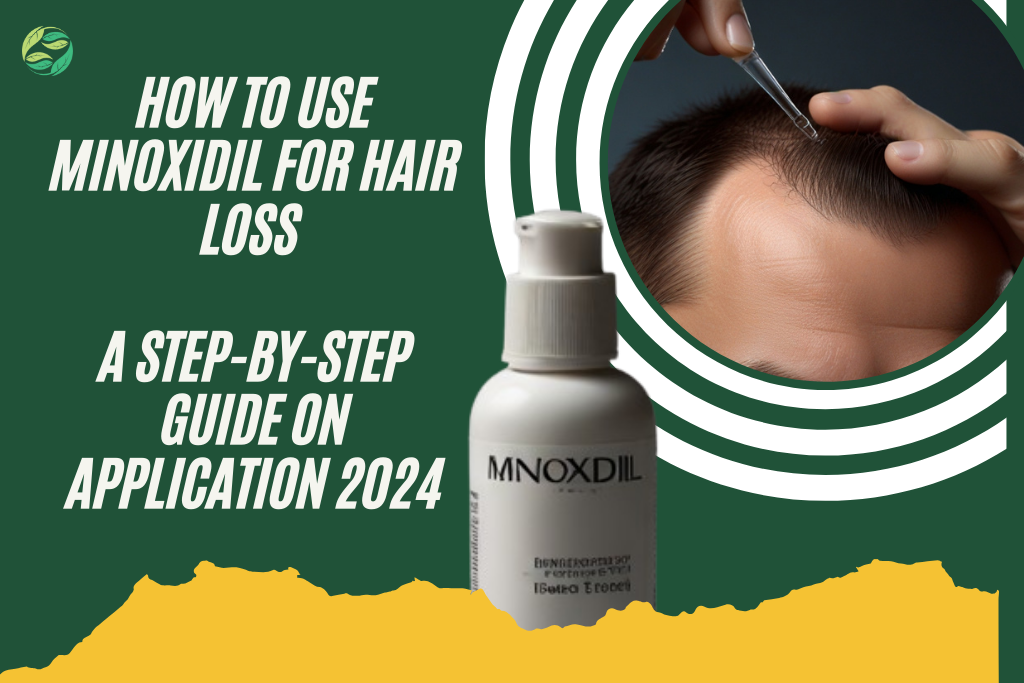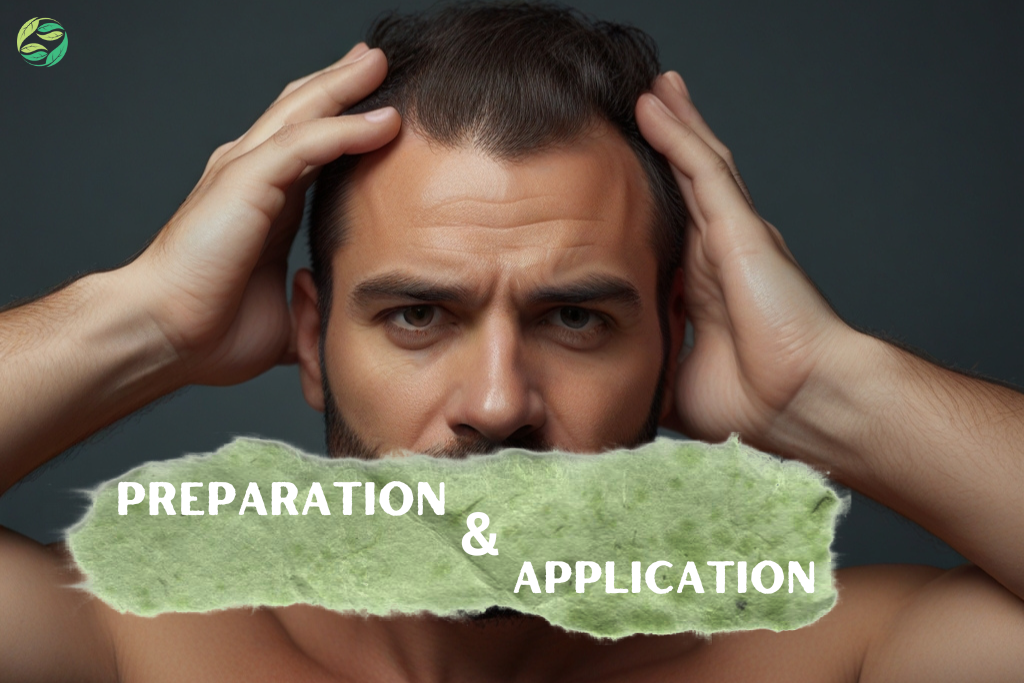More people than you think struggle with hair loss. It’s a widespread issue that impacts both men and women. It can be a source of frustration and emotional distress, impacting self-confidence and overall well-being. Fortunately, there are options available to help manage hair loss and potentially promote regrowth. One such option is minoxidil, a topical medication that has been shown to be effective in stimulating hair growth for certain types of hair loss.

Minoxidil comes in solution or foam form and is applied directly to the scalp. While the exact mechanism of how minoxidil works is not fully understood, it is thought to stimulate blood flow to the hair follicles and may prolong the growth phase of the hair cycle. This can lead to increased hair density and thickness over time with consistent use.
This article will serve as your comprehensive guide on how to use minoxidil for hair loss. We will provide a step-by-step breakdown of the application process, important considerations for use, and when to consult a doctor.
Understanding Minoxidil
For those new to using minoxidil, understanding the different formulations and strengths available can be helpful when choosing the right product. Minoxidil comes in two main topical applications: solution and foam. The solution is a liquid applied directly to the scalp using a dropper, while the foam is a lightweight aerosol dispensed onto the scalp. Both formulations require consistent use to achieve results, but some users may find the foam easier to apply and less messy due to its texture.
Minoxidil also comes in various strengths, typically ranging from 2% to 5%. The most appropriate strength for you will depend on the severity of your hair loss and your doctor’s recommendation. It’s important to note that a higher strength doesn’t necessarily equate to faster or better results. It’s always best to consult a doctor to determine the most suitable formulation and strength of minoxidil for your individual needs. While this article provides a general guide on how to use minoxidil, consulting a doctor can ensure you get the most effective treatment plan for your hair loss.

I. How to Use Minoxidil for Hair Loss: A Step-by-Step Guide
Now that you have a better understanding of minoxidil, let’s delve into the details of its application. Consistent and proper use is crucial for maximizing the effectiveness of minoxidil. Here’s a step-by-step guide to ensure you’re using it correctly:
Preparation:
- Washing: It’s generally recommended to wash your hair before applying minoxidil. However, some product instructions may advise otherwise. Always refer to the specific instructions that come with your chosen minoxidil product. If your doctor recommends clarifying your hair to remove any product buildup before application, use a gentle clarifying shampoo.
- Drying: This step is essential. Ensure your scalp and hair are completely dry before applying minoxidil. Moisture can hinder the absorption of the medication. Towel-dry your hair thoroughly and allow it to air dry completely for at least 30 minutes before proceeding.
Application:
Dosage: The typical recommended dosage for most minoxidil solutions is 1 milliliter (mL). This measurement is usually marked on the dropper that comes with the solution. Always follow the specific dosage instructions provided with your product.
Solution Application:
- Parting your hair: Part your hair in several sections to expose the scalp where you’re experiencing hair loss. This will allow for easier application and ensure you reach the targeted areas effectively.
- Using the dropper: Fill the dropper to the designated 1mL mark with the minoxidil solution.
- Applying to the scalp: Apply the solution directly to your scalp using the dropper, focusing on the areas with the most significant hair loss. Focus on applying it to your scalp instead.
- Massaging: Gently massage the applied solution into your scalp with your fingertips. This helps distribute the medication evenly and promote absorption.
Foam Application:
- Dispensing foam: Hold the minoxidil foam can upside down and dispense a half-capful amount onto your palm.
- Applying to affected areas: Apply the foam directly to the affected areas of your scalp, using your fingertips to gently spread it evenly.
- Massaging: Similar to the solution, gently massage the applied foam into your scalp to ensure proper absorption.
General Application Considerations:
- Coverage: Depending on your product instructions, you may need to apply minoxidil to your entire scalp or just the affected areas. Refer to the specific directions for your chosen formulation.
- Avoid contact: Be mindful to avoid getting minoxidil in your eyes, nose, mouth, or any broken or irritated skin. If accidental contact occurs, rinse the affected area thoroughly with cool tap water.
After Application:
- Drying time: Allow the applied minoxidil solution or foam to dry completely on your scalp before styling your hair or going to bed. This typically takes around 30 minutes.
Handwashing: Wash your hands thoroughly with soap and water after applying minoxidil to avoid transferring any residue to other parts of your body, especially your face.
II. Important Considerations for Using Minoxidil
While minoxidil offers a valuable tool for managing hair loss, it’s essential to understand some key factors for its effective and safe use. To make an informed decision, here are a few key things to think about.
- Frequency of Use: For optimal results, minoxidil is typically recommended to be used twice daily. Most users apply it once in the morning and once before bed. Consistency is paramount, so try to establish a routine that integrates minoxidil application seamlessly into your daily regimen.
- Potential Side Effects: Like any medication, minoxidil can cause side effects in some users. The most common side effects are usually mild and temporary, affecting the scalp specifically. These may include scalp irritation, dryness, itching, or burning sensation. If you experience any persistent or severe scalp irritation, it’s advisable to discontinue use and consult your doctor. In rare cases, unwanted hair growth can occur outside the intended application area, such as the forehead or cheeks. If this happens, consult your doctor to discuss alternative treatment options.
- Timeline for Results: It’s important to have realistic expectations when using minoxidil. It’s not an overnight fix, and seeing noticeable results can take several months of consistent use. Studies typically suggest a timeframe of at least 2 to 4 months before any significant hair regrowth is observed. Be patient and continue using the medication as directed for optimal results.
- Importance of Consistent Use: Minoxidil works by stimulating the hair growth cycle. Once you stop using it, the hair follicles will eventually return to their previous growth phase, and any regrown hair may shed. Therefore, consistent use of minoxidil is crucial to maintain its benefits and prevent further hair loss. If you’re considering stopping treatment, discuss it with your doctor to determine the best course of action for your individual situation.
III. When to Talk to a Doctor
Minoxidil is generally well-tolerated, but there are situations where consulting a doctor is recommended. Here’s when seeking professional guidance is advisable:
- Significant Scalp Irritation: As mentioned previously, scalp irritation is a common side effect of minoxidil. However, if you experience persistent or severe scalp irritation, redness, or burning that doesn’t improve with continued use, discontinue using minoxidil and consult your doctor. They can assess the cause of the irritation and recommend alternative treatment options if necessary.
- Unexpected Side Effects: While some side effects are well-documented, there’s always a chance of experiencing unexpected reactions. If you notice any unusual side effects beyond mild scalp irritation, such as dizziness, rapid heartbeat, or unexplained weight gain, stop using minoxidil and consult your doctor immediately. They can help determine the cause of these side effects and recommend the appropriate course of action.
- Lack of Improvement: If you’ve been using minoxidil consistently for several months (typically 4 months or more) and haven’t observed any noticeable improvement in hair growth, consult your doctor. They can re-evaluate your diagnosis, assess the effectiveness of the treatment, and potentially explore alternative hair loss management strategies if necessary. It’s important to remember that minoxidil may not be equally effective for everyone, and sometimes, a different treatment approach may be more suitable for your specific needs.
IV. Conclusion
Minoxidil can be a valuable tool for promoting hair growth and managing hair loss. By following the steps outlined in this guide on how to use minoxidil effectively, you can maximize its benefits and potentially experience positive results. Remember, consistency is key. Consistent use of the recommended dosage and proper application technique are crucial for achieving optimal results.
Let’s refresh our memory on the main points.
- Ensure your scalp and hair are completely dry before applying minoxidil.
- Apply the recommended dosage (typically 1ml for solutions) directly to the scalp, focusing on affected areas.
- Gently massage the applied solution or foam into your scalp for proper absorption.
- Don’t style your hair or hit the hay until the minoxidil is totally dry.
- Wash your hands thoroughly after application.
- Use minoxidil consistently, typically twice daily, for optimal results.
Hair loss treatments affect people in various ways, so results may differ. While minoxidil can be effective for many, it may not be suitable for everyone. Additionally, if you experience any concerning side effects or lack of improvement after several months of consistent use, consult your doctor. They can provide personalized guidance and ensure you’re on the right track to achieving your hair loss management goals.
Disclaimer: The information provided in this article is for general informational purposes only and should not be construed as medical advice. It is important to consult with a qualified healthcare professional to discuss your specific situation and determine if minoxidil is the right treatment option for you. They can provide personalized guidance on proper usage, potential side effects, and answer any questions you may have.
FAQs on Using Minoxidil for Hair Loss
1. Is minoxidil safe for everyone to use?
Minoxidil is generally safe for most people, but it’s not suitable for everyone. Pregnant or breastfeeding women, individuals with certain scalp conditions, and people with a history of allergic reactions to minoxidil or any of its ingredients should avoid using it. It’s always best to consult your doctor before starting minoxidil to ensure it’s safe for you.
2. Can I use minoxidil with other hair loss treatments?
While minoxidil can be used in conjunction with other hair loss treatments, it’s important to talk to your doctor first. Certain medications may interact with minoxidil, so getting your doctor’s approval is crucial to ensure their safe and effective combined use.
3. Are there any lifestyle changes that can help improve the effectiveness of minoxidil?
Maintaining a healthy lifestyle can support overall hair health and potentially contribute to the effectiveness of minoxidil. This includes managing stress levels, eating a balanced diet rich in essential nutrients, and getting enough sleep.
4. What happens if I stop using minoxidil?
Once you stop using minoxidil, the hair growth cycle will return to its previous phase. Any hair regrowth you experienced due to minoxidil use will likely shed, and you may experience further hair loss. Consistent use is essential to maintain the benefits of minoxidil.
5. Are there any natural alternatives to minoxidil?
While some natural ingredients may promote scalp health, there’s no scientific evidence to support their effectiveness in hair regrowth to the same extent as minoxidil. However, some people find that maintaining a healthy scalp with natural oils or shampoos can help manage hair loss to a certain degree. It’s important to note that these are not substitutes for minoxidil and may not be as effective. Consulting a dermatologist can help explore various hair loss management options, including natural approaches that may complement your treatment plan.
Maximize Hair Growth Naturally 2024: Top Strategies to Unlock Rapunzel Hair

Just wish to say your article is as surprising The clearness in your post is just cool and i could assume youre an expert on this subject Fine with your permission allow me to grab your RSS feed to keep updated with forthcoming post Thanks a million and please keep up the enjoyable work
helloI like your writing very so much proportion we keep up a correspondence extra approximately your post on AOL I need an expert in this space to unravel my problem May be that is you Taking a look forward to see you
Attractive section of content I just stumbled upon your blog and in accession capital to assert that I get actually enjoyed account your blog posts Anyway I will be subscribing to your augment and even I achievement you access consistently fast
Loving the information on this website , you have done outstanding job on the articles.
The posts inspire me regularly. The depth you bring to The topics is truly exceptional.
Each post is a journey, and The words are the map. Thanks for leading the way.
Making hard to understand concepts readable is no small feat. It’s like you know exactly how to tickle my brain.
Thanks for sharing. I read many of your blog posts, cool, your blog is very good.
The prose is as smooth as silk, making hard to understand topics feel like a gentle caress to my mind.
Making hard to understand topics accessible is a gift, and you have it. Thanks for sharing it with us.
You have a gift for explaining things in an understandable way, much like a smooth talker who knows just what to say.
Thanks for sharing. I read many of your blog posts, cool, your blog is very good.
You’ve done a fantastic job of breaking down this topic. Thanks for the clarity!
Thanks for sharing. I read many of your blog posts, cool, your blog is very good.
The Writing has become a go-to resource for me. The effort you put into The posts is truly appreciated.
The clarity and thoughtfulness of The approach is as appealing as a deep conversation over coffee.
Compelling read with well-presented arguments. I almost felt persuaded. Almost.
I believe you have noted some very interesting points, regards for the post.
A masterpiece of writing! You’ve covered all bases with elegance.
I’m always excited to see The posts in my feed. Another excellent article!
This post was a breath of fresh air, like a surprise message that brightens The day. Thank you for the lift.
I’m genuinely impressed by the depth of The analysis. Great work!
Thanks for sharing. I read many of your blog posts, cool, your blog is very good.
Thank you for the awesome content, it’s always appreciated